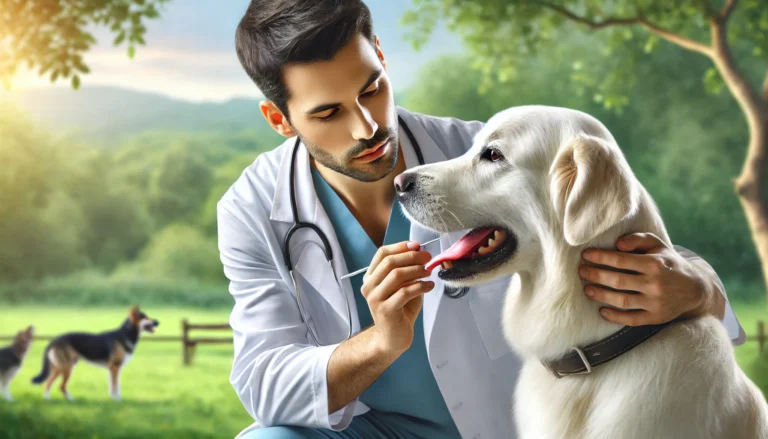Epulis in Dogs (Benign Gum Growth)

Epulis in dogs refers to a type of benign tumor that typically appears in the gums. While epulides (the plural form) are usually non-cancerous, they can cause discomfort, interfere with a dog’s ability to eat, and in some cases, lead to other health complications. Understanding the different types of epulis, the causes, symptoms, diagnosis, and treatment options is essential for ensuring your dog’s health and well-being.
1. What is Epulis in Dogs?
Epulis is a non-cancerous growth that typically appears on the gums of a dog. These growths may be small or large, and while they are generally benign, they can lead to problems if left untreated. Epulides tend to affect the areas around the teeth and gums, which can cause difficulty in eating, swelling, or infection. There are different types of epulis, and they vary in appearance and behavior.
2. Types of Epulis in Dogs
Epulis in dogs can be classified into four main types based on its location and growth patterns:
2.1. Fibromatous Epulis
Fibromatous epulis is the most common type of epulis in dogs. It appears as a firm, fleshy mass on the gums and is often located around the canine teeth. This type of epulis is usually slow-growing and doesn’t typically spread to other parts of the body.
2.2. Ossifying Epulis
Ossifying epulis is similar to fibromatous epulis, but it has a bone-like structure in its tissue. This type of epulis can be more rigid and can sometimes cause more significant discomfort due to its solid nature. It often affects older dogs, particularly those with a history of dental issues.
2.3. Acanthomatous Epulis
Acanthomatous epulis is considered the most aggressive type of epulis. It tends to invade surrounding tissues and can affect both the gums and the bone structure of the jaw. Though still benign, acanthomatous epulis requires more aggressive treatment due to its tendency to spread.
2.4. Malignant Epulis
Although rare, there is a form of epulis that can develop into a malignant tumor. This is more common in older dogs, and its malignant form can spread to other areas. It’s essential to catch this type early, as it requires more aggressive treatment, including possible surgery and chemotherapy.
3. Causes of Epulis in Dogs
The exact cause of epulis in dogs is not always known, but several factors can contribute to the development of this condition:
3.1. Genetics
Certain dog breeds are more prone to developing epulis, particularly those with a history of dental problems. Breeds such as Boxers, Bulldogs, and Dachshunds have been found to be more susceptible to this condition.
3.2. Poor Dental Hygiene
Like many oral health issues, poor dental hygiene can increase the risk of epulis. Accumulation of plaque and tartar can lead to irritation and inflammation of the gums, making it more likely for epulides to develop.
3.3. Age
Epulis is more common in middle-aged to older dogs, with most cases being diagnosed in dogs over the age of five. As dogs age, they are more likely to develop oral health issues, including tumors like epulis.
3.4. Hormonal Imbalances
Some studies suggest that hormonal changes or imbalances might contribute to the development of epulis. This is particularly relevant for female dogs, as some types of epulis are more common in females, especially those that have not been spayed.
4. Symptoms of Epulis in Dogs
The symptoms of epulis in dogs can vary depending on the size and location of the tumor. Common signs include:
4.1. Swelling in the Gums
One of the most noticeable symptoms is swelling or growth on the gums, typically near the teeth. The growth may be small at first but can grow larger over time.
4.2. Difficulty Eating or Chewing
Epulides can cause discomfort, making it difficult for a dog to chew or eat. This may lead to a decrease in appetite or the dog avoiding certain types of food.
4.3. Bleeding or Inflamed Gums
If the epulis grows large enough, it can irritate the surrounding tissues, causing the gums to become inflamed and even bleed. This may also result in bad breath or a change in the dog’s eating habits.
4.4. Lumps in the Mouth
Dogs with epulis may have a noticeable lump in the mouth, typically along the gumline, near the teeth. These lumps can be either hard or soft depending on the type of epulis.
4.5. Tooth Mobility
If the tumor affects the bone and surrounding tissues, it can result in loose teeth or changes in the dog’s bite.
5. Diagnosing Epulis in Dogs
The diagnosis of epulis typically begins with a thorough examination by a veterinarian. In addition to a physical exam, your vet may use various diagnostic tools to confirm the presence and type of epulis:
5.1. Physical Examination
A visual inspection of the mouth and gums will allow the veterinarian to identify any unusual lumps or swelling. The location and appearance of the growth help the vet determine if it’s an epulis or another type of oral growth.
5.2. Dental X-rays
To assess the extent of the epulis, dental X-rays may be taken. This allows the vet to see if the growth has affected the jawbone or surrounding tissues.
5.3. Biopsy
In some cases, a biopsy may be necessary to confirm that the growth is benign. A small tissue sample is taken and sent to a laboratory for analysis to rule out any malignant growths.
5.4. Fine Needle Aspiration (FNA)
Fine needle aspiration can also be used to obtain a sample of the tumor for further examination. This is a less invasive option compared to a biopsy.
6. Treatment Options for Epulis in Dogs
Treatment for epulis depends on the size, type, and location of the growth, as well as the dog’s overall health. Common treatment options include:
6.1. Surgical Removal
The most common treatment for epulis is surgery. If the tumor is localized and hasn’t spread to surrounding tissues, your veterinarian may recommend surgically removing the growth. In some cases, this can be done under local anesthesia, but in others, general anesthesia may be required.
6.2. Radiation Therapy
For more aggressive types of epulis, such as acanthomatous epulis, radiation therapy may be recommended after surgical removal. This can help ensure that any remaining cancerous cells are destroyed.
6.3. Cryosurgery
Cryosurgery, or freezing the tumor, is another treatment option that can be used for small epulides. This method is less invasive and can be effective for certain types of epulis.
6.4. Chemotherapy
In the rare case of malignant epulis, chemotherapy may be used to treat the cancerous cells. Chemotherapy is often combined with surgery or radiation therapy to improve the chances of a full recovery.
6.5. Post-Surgical Care
After surgery, your dog may need post-operative care, including pain management, antibiotics to prevent infection, and follow-up visits to ensure proper healing. Regular check-ups will also be necessary to monitor for any recurrence of the growth.
do you know
Some cats may require ongoing management to keep acne at bay, including regular veterinary check-ups, continuous use of specialized grooming products, and possibly long-term dietary adjustments.
7. Preventing Epulis in Dogs
While you can’t entirely prevent epulis in dogs, there are steps you can take to reduce the risk and support your dog’s oral health:
7.1. Regular Dental Check-ups
Frequent dental check-ups are essential to detect any oral health issues early. Your veterinarian can spot potential problems before they develop into serious conditions like epulis.
7.2. Proper Oral Hygiene
Brushing your dog’s teeth regularly helps prevent plaque buildup, which can contribute to the development of gum disease and tumors. You can also use dental chews and toys to help maintain good oral hygiene.
7.3. Healthy Diet
Providing your dog with a healthy diet that promotes good oral health is important. Certain foods and treats designed to support gum health can help reduce the risk of epulis.
7.4. Spaying and Neutering
Because hormonal imbalances can contribute to epulis development, spaying or neutering your dog may reduce the risk, especially in females.
8. Conclusion: Managing Epulis in Dogs
Epulis in dogs is a common yet treatable condition that affects the gums and oral cavity. While the condition is usually benign, it can cause significant discomfort and lead to complications if not addressed promptly. Early detection, proper diagnosis, and treatment are essential for managing epulis and ensuring that your dog remains healthy and comfortable.If you suspect your dog has epulis or any other oral growth, it’s crucial to consult with a veterinarian as soon as possible. With the right care and attention, your dog can continue to lead a happy, healthy life even after an epulis diagnosis.
What causes epulis in dogs?
Epulis in dogs is a type of oral tumor that originates from the gum tissue. The exact cause of epulis is not entirely understood, but it is believed that chronic irritation, such as from poor dental hygiene, might contribute to its development. Breeds like Boxers and Dobermans are more susceptible, possibly due to genetic factors. It’s important to consult a veterinarian if any abnormal growths or changes in your dog’s mouth are noticed, as early detection can help in determining the best course of treatment for the topic of epulis.
How long can a dog live with epulis?
The life expectancy of a dog with epulis depends on several factors, including the size and location of the tumor and whether it has been removed or treated. If the tumor is benign and treated early, the prognosis is generally positive, and the dog can live for many more years. However, if left untreated or if the epulis becomes malignant, it can cause complications. Regular check-ups are vital for monitoring the topic of epulis to ensure the dog’s well-being.
What are the symptoms of epulis?
Symptoms of epulis in dogs include swelling or a lump in the gums, especially near the teeth, which may be visible in the mouth. In some cases, the tumor can cause bad breath, difficulty eating, drooling, or bleeding from the mouth. These signs often appear gradually, so if you notice any changes in your dog’s oral health, it’s important to seek veterinary care to address the topic of epulis early on.
Should epulis be removed?
Epulis should generally be removed, especially if it is causing discomfort, interfering with the dog’s ability to eat, or if there is any concern it may be malignant. Surgery is often the preferred method of treatment because it eliminates the tumor and provides a chance for complete recovery. However, whether removal is necessary depends on the size, location, and type of epulis. Discussing the best course of action with a vet is crucial when dealing with the topic of epulis.
How is epulis treated?
Epulis is typically treated through surgical removal of the tumor. In some cases, if the epulis is benign and localized, the removal may be relatively simple and have a good prognosis. After surgery, follow-up care is important to monitor for any recurrence. In certain cases, other treatments like laser therapy or cryotherapy may be considered, depending on the size and location of the epulis. It’s essential to work with your veterinarian to determine the most appropriate treatment for the topic of epulis.






